Monday, November 1, 2010
1972-73 Minnesota Fighting Saints Terry Ball Jersey
October 31st, Halloween, is sometimes referred to as "All Hallows Eve", making November 1st "All Hallows", with "hallows" being defined as "to consecrate or set apart as being holy". Thus, All Hallows celebrates all those who have been set apart as being holy by being named to sainthood, which leads to another name for All Hallows - "All Saints' Day".
A search of HockeyDB.com reveals twenty teams named "Saints" at various levels of hockey as far back as 1925 with the original incarnation of the St. Paul Saints of the Central Hockey League. The Saints then moved to the American Hockey Association for four seasons, back to the CHL for four, which included winning the league championship in 1935, and once more back to the AHA for seven seasons until World War II brought a temporary halt to the league. When play resumed in 1945, the Saints were now part of the United States Hockey League until 1955 and took home the championship in 1949.
The 1948-49 USHL champion St. Paul Saints
In 1959 the St. Paul Saints name would be revived with a new franchise in the International Hockey League, which would continue play through 1963 until their name was changed to the St. Paul Rangers to reflect their affiliation with the NHL's New York Rangers. This edition of the Saints was quite successful, appearing in the Turner Cup Finals three consecutive seasons, winning championships in both 1960 and 1961 and having their reign ended in 1962.
The 1960 IHL Champion St. Paul Saints
Next on the scene was the St. Catharines Saints in 1940 in the Ontario Hockey Association in Canada. That club lasted only two seasons, but the name was revived in 1982 when a new club joined the American Hockey League in 1982. That club stayed for four seasons prior to a relocation to Newmarket, Ontario where they were now known as the Newmarket Saints until 1991. After another relocation resulted in a name change, followed by yet another in 2005 which currently has them known as the Toronto Marlies.
A little known club in Minnesota called the Hibbing Saints played for one season in the Northern Hockey League. The fourth Saints franchise was the Sherbrooke Saints of the Quebec Senior Hockey League from 1949 to 1954.
The St. Boniface Saints had a long run in the Manitoba Junior Hockey League from 1967 to 2001 before new owners renamed them the Winnipeg Saints where they continue to play in Canadian Tier II Junior "A" hockey.
The 1992-93 St. Boniface Saints
Also formed in 1967, the Windsor St. Clair Saints played in the Ontario Colleges Athletic Association and dominated with championships in 1968, 1969, 1970, 1973, 1975, 1976, 1977 and 1979. They also won the Canadian Colleges Athletic Association National Championship in 1976.
After an extended break from competition, the St. Clair Saints returned in 2001 and won the OCAA championship in 2002 and 2003. Following the demise of the OCAA, the Saints eventually joined Major League Hockey, playing against Senior AAA level teams from 2006 to 2008 before ceasing operations.
The St. Claire Saints pay a hospital visit in 2008
The Laval Saints of the Quebec Major Junior Hockey League lasted but one season in 1969-70.
The next club to arrive on the scene with the Saints name did so with a twist. As founding members of the World Hockey Association in 1972 based in St. Paul, Minnesota, the new club elected to call themselves the Minnesota Fighting Saints. They created one of the best logos hockey has ever seen, which has been copied again and again since then. The Fighting Saints also played a firey, uptempo brand of hockey with plenty of fisticuffs and occasional mayhem thrown in to live up to the team name.
Competing with the NHL's Minnesota North Stars, who were in a down period on the ice at the time, the always competitive Fighting Saints captured the hearts of the Minnesota hockey fans and played to several record setting capacity crowds of over 17,000 at their brand new St. Paul Civic Center on the current site of the Minnesota Wild's Xcel Energy Center.
The 1973-74 Minnesota Fighting Saints
The Fighting Saints lasted four seasons in the unstable WHA and never missed the playoffs or had a losing record. After the original blue-clad WHA Fighting Saints folded during the 1975-76 season, the Cleveland Crusaders relocated to St. Paul for 1976-77 and adopted the Fighting Saints name and logo, but changed their primary color to red to differentiate themselves from the original club. This version of the Fighting Saints lasted only 42 games before also calling it quits.
Surprisingly, there haven't been more teams from St. Louis named the Saints, but there was one such club, the St. Louis Saints, which competed in the Continental Hockey League for two years starting in 1974.
The tenth Saints club, a junior hockey team from Ecorse, Michigan named the Paddock Pool Saints was active from 1975 to 1984 in the Great Lakes Junior Hockey League. The St. Albert Saints (1977-2004) were members of the Alberta Junior Hockey League, not to be confused with the Saskatchewan Junior Hockey League's Prince Albert Saints, who played in 1980-81.
Despite their short life, the Minnesota Fighting Saints popularity influenced several subsequent teams at various levels, including the Dubuque Fighting Saints (1980-2001) of the United States Hockey League, the Danville Fighting Saints (1986-1989) of the All American Hockey League and the St. Paul Fighting Saints (1992-93) of the American Hockey Association. A new version of the Dubuque Fighting Saints began play in the USHL just this fall.
Going overseas, the Glasgow Saints of Scotland competed in the British Hockey League during the 1990-91 season, but failed to survive beyond that.
The San Angelo Saints who were members of the Central Hockey League from 2002-2005 and the Spruce Grove Saints of the Alberta Junior Hockey League are the relocated St. Albert Saints a franchise which can be traced back to 1963 with several different names.
The 2009-10 Spruce Grove Saints
Finally the the New York Saints of the Metropolitan Junior Hockey League arrived in 2006.
Today's featured jersey is a 1972-73 Minnesota Fighting Saints Terry Ball jersey. Ball had a long career which took many twists and turns along the way. He began with the Winnipeg Rangers of the Manitoba Junior Hockey League in 1962. After another season in Winnipeg, Ball graduated to the Vancouver Canucks of the WHL. The following season he played with the Kitchener Rangers of the Ontario Hockey Association. He moved up to the CPHL with the Minnesota Rangers in 1985 and moved with the team to Omaha the following season.
The great NHL expansion of 1967 created an opportunity for Ball, who made his NHL debut with the Philadelphia Flyers with a single game in 1967-68 but spent the majority of that season with the Quebec Aces of the AHL. After one more season with Quebec, Ball returned to the Flyers for 61 games in 1969-70 as well as 10 final games with the Aces.
The 1970-71 season was an unsettled one for Ball, as he played for the Amarillo Wranglers of the CHL, the Salt Lake Golden Eagles in the WHL and a pair of games with the Buffalo Sabres. He spent the majority of the 1971-72 season with the Cinncinnati Swords in the AHL as well as another 10 games with the Sabres, the final games of the NHL portion of his career.
With the WHA starting play in 1972, another opportunity was presented to Ball, who signed on with the Minnesota Fighting Saints, where he would find the most stability of his career, playing three full seasons as one of the stalwarts on the blueline.
Ball was popular with the fans in Minnesota, primarily for his uncanny ability to deliver the most spectacular hip checks, as he would skate backwards at a high rate of speed, bend completely over at the waist, and back into the path of an onrushing forward, who would collide with Ball's hip, which would sent him flipping heels over head due to the fulcrum created by the bent over Ball's hip! A normal body check would have the attacking player's upper body collide with the defender, stopping his progress, but with Ball bent over, there was no upper body there to arrest their momentum, and over they would go to the delight of the fans and photographers!
Ball would play two more WHA seasons after leaving Minnesota, spending one split between the Cleveland Crusaders and Cincinnati Stingers and then 23 games the next season with the Birmingham Bulls of the WHA and Oklahoma City Blazers of the CHL. Ball had one last stop on his journey thorough the hockey world, as he would take his game to Finland where he played the 1977-78 season and 6 games in 1978-79 with HIFK Helsinki before calling it a career after 15 seasons.
If the Fighting Saints jersey appears familiar at first glance, is probably is, as the Fighting Saints minor league affiliate the Johnstown Jets was the inspiration for the Charlestown Chiefs of the famed move "Slap Shot", and the movie Chiefs wore jerseys of the same color and striping template as Johnstown, who mimicked the jerseys of their parent club, the Fighting Saints.
This jersey was actually not the original Fighting Saints jersey, as they began play with jerseys featuring a large "S" logo before a second set of jersey featuring the "Little Saint" logo was put into use.
Bonus Jersey: Today's bonus jersey is a 1984-85 St. Catharines Saints Gary Leeman jersey. Leeman was a ten year member of the Toronto Maple Leafs of the NHL, but did play 7 and then 25 games over two seasons with St. Catharines of the AHL early in his career. Leeman would later go on to win a Stanley Cup with the Montreal Canadiens in 1993 and score 466 points in 667 NHL games.
This jersey clearly reflects the then current style of the Saints parent club, the Toronto Maple Leafs. While copying the parent club's jersey style was the norm back then, many minor league clubs have learned the value of having their own separate identity when it comes to their own income through sales of unique merchandise and jerseys.
Today's video segment is a peek into the crazy world of the Minnesota Fighting Saints of the WHA, when one of the players beat up his own coach!
This second video is a highlight film of the Fighting Saints first season of 1972-73. Keep and eye out for #21 Terry Ball in the film. Also, notice the gold alternate jerseys with the original "S" logo, none of which are known to have survived, as the logos were removed and they were handed down to a local high school who shared the same colors.
Once the Little Saint logo appeared on their jerseys, they Fighting Saints limited themselves to just home white and road blue jerseys.
Another thing to be aware of are the unique clear boards used in the St. Paul Civic Center, which allowed fans a view of the puck at all times, particularly those fans in the first several rows of seats, which were set back from the boards by a fair distance due to the round layout of the Civic Center.
If you are interested in some rare St. Paul Saints for Minnesota Fighting Saints jerseys, our friends at VintageMinnesotaHockey.com have a series of excellent reproductions of not only the WHA's Minnesota Fighting Saints, more accurate than anything found anywhere else online, but also a series of St. Paul Saints jerseys from the minor league club from the 1930's to the 1960's. Just do a search for "Saints" to view your options.
P.S. Happy Birthday to Kelly, without whose patience and understanding this blog would not be possible.
Labels:
Ball Terry,
Minnesota Fighting Saints
Subscribe to:
Post Comments (Atom)

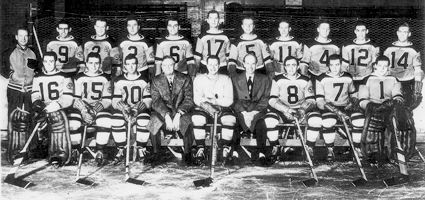
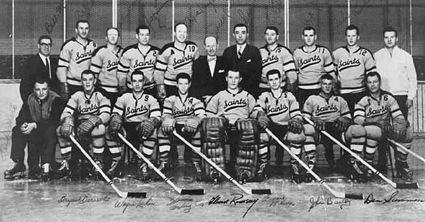
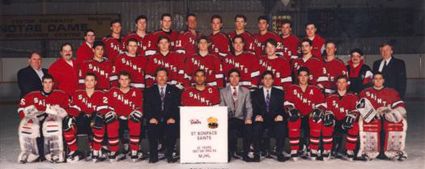

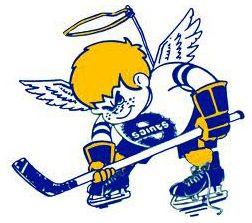




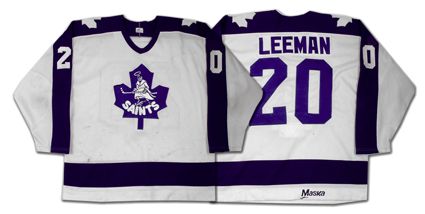
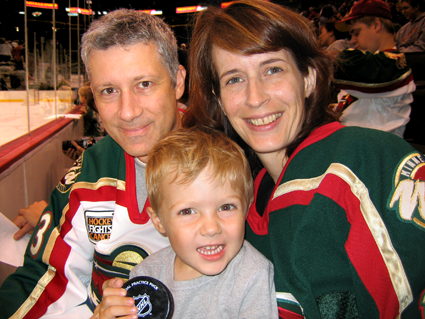










No comments:
Post a Comment
We welcome and encourage genuine comments and corrections from our readers. Please no spam. It will not be approved and never seen.